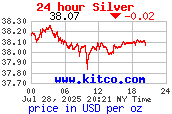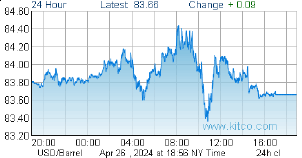TSX Venture Exchange and Gold
The Venture traded within a tight range last week but closed Friday at its weekly high of 699.43 after dipping as low as 690 Monday, just above its rising 50-day moving average (SMA). Particularly encouraging was how the Venture held its ground in the face of Gold’s weakness following Wednesday’s Fed statement. The TSX Gold Index also outperformed the yellow metal and pushed through some important resistance in the process.
The Venture still faces its own stiff resistance, of course, just slightly above 700. An eventual breakout through 707-708 seems inevitable given the bullish indicators showing up in longer-term charts as we pointed out in Friday’s Morning Musings, but exact timing is impossible to predict. Fortunately for the Venture, the greenback is in the midst of a correction – it’s possible the Dollar Index may have hit its yearly high in mid-March after a massive surge from last summer that severely impacted the commodity sector.
The Venture has advanced in 6 out of the last 7 weeks and actually enjoyed its best April since 2010 with a gain of 2.3%. The Index also again confirmed superb support around 680 on the monthly chart. What’s intriguing at the moment is that the Venture’s 100-day SMA, in the mid-680’s, is now just beginning to reverse to the upside. Historically, this has always coincided with a favorable market environment for at least a few months or, in some cases, actually marked the beginning of a very powerful bull phase.
Venture 5-Month Daily Chart
RSI(14) on this 5-month daily chart bounced off the 50% level last week, which is encouraging, though the CMF still shows weak sell pressure. The rising 20-day SMA, currently 697, appears to be providing support. The Index could be gearing up to test resistance again in the coming days.
Venture Seasonality Chart
The Venture’s performance last month ran against the norm which is interesting – traditionally, April and June are the weakest months of the year. The second quarter is typically when the Venture stumbles but 2015 could be different.
The Seeds Have Been Planted (And Continue To Be Planted) For The Next Big Run In Gold Stocks
There’s no better cure for low prices than low prices. The great benefit of the collapse in Gold prices in 2013 is that it forced producers (at least most of them) to start to become much more lean in terms of their cost structures. Producers, big and small, have started to make hard decisions in terms of costs, projects, and rationalizing their their overall operations. Exploration budgets among both producers and juniors have also been cut sharply. In addition, government policies across much of the globe are making it more difficult (sometimes impossible) for mining companies to carry out exploration or put Gold (or other) deposits into production, thanks to the ignorance of many politicians and the impact of radical and vocal environmentalists (technology has made it easier for groups opposing mining projects to organize and disseminate information, even in remote areas around the globe). Ultimately, all of these factors are going to eventually create a supply problem and therefore great opportunities in Gold and quality Gold stocks. Think about it, where are the next major Gold deposits going to come from? On top of that, grades have fallen significantly just over the past decade.
Gold
Gold bounced around last week and finished down $2 an ounce at $1,178 despite a worse than expected U.S. GDP number and a Fed statement that could be interpreted as quite Gold bullish – there’s no indication the central bank will be hiking rates until at least September, and perhaps not even until 2016. April’s jobs report, due this coming Friday, will likely determine if Gold can snap out of a 4-week losing streak.
Gold stocks, however, continue to do better relative to the metal. John has an interesting chart to share tomorrow regarding this.
Below is an update of one of our favorite Gold charts as it gives the “Big Picture” of how Gold has meandered within a downsloping flag for the past two-and-a-half years. Quite simply, resistance is at the top of the flag and support is at the bottom, while RSI(14) – currently at 43% – has moved within a 30% to 60% channel. At some point, bullion will either break out above the flag or crash below it. At the moment it’s trading in the lower half of its range but near very strong support at $1,150.
Silver, which usually moves ahead of Gold, snapped its 4-week losing skid with a gain of 34 cents (updated Silver charts in Monday’s Morning Musings as usual). Copper climbed higher to $2.90. Crude Oil enjoyed another good week, climbing $1.84 a barrel to $59.26 while the U.S. Dollar Index lost more than one-and-a-half points to 95.21.
As Frank Holmes so effectively illustrates at www.usfunds.com, the long-term bull market in Gold has been driven by both the Fear Trade and the Love Trade. The transfer of wealth from west to east, and the accumulation of wealth particularly in China and India, has had a huge impact on bullion and will continue to support prices. Despite Gold’s largest annual drop in three decades in 2013, the fundamental long-term case for the metal remains solidly intact based on the following factors:
- Growing geopolitical tensions, fueled in part by the ISIS and al Qaeda, and a highly dangerous and expansionist Russia under Vladimir Putin, have put world security in the most precarious state since World War II;
- Weak leadership in the United States and Europe is emboldening enemies of the West;
- Currency instability and an overall lack of confidence in fiat currencies, except King Dollar at the moment;
- Historically low interest rates;
- Continued strong accumulation of Gold by China which intends to back up its currency with bullion;
- Massive government debt from the United States to Europe – a “day of reckoning” will come;
- Continued net buying of Gold by central banks around the world;
- The Oil price plunge since last year which may cause destabilization of certain Oil-dependent economies;
- Mine closings, a sharp reduction in exploration and a lack of major new discoveries – these factors should contribute to a noticeable tightening of supply over the next couple of years.
 BullMarketRun.ca
BullMarketRun.ca


 A slew of U.S. economic data this morning…the pace of manufacturing growth held at its slowest in almost 2 years in April, as a rebound in new orders was offset by employment shrinking to its lowest level in more than 5 years…the Institute for Supply Management (ISM) said its index of national factory activity was 51.5 in April, matching the March reading, which had been the lowest since May 2013…the reading fell shy of expectations of 52.0, according to a Reuters poll of economists…
A slew of U.S. economic data this morning…the pace of manufacturing growth held at its slowest in almost 2 years in April, as a rebound in new orders was offset by employment shrinking to its lowest level in more than 5 years…the Institute for Supply Management (ISM) said its index of national factory activity was 51.5 in April, matching the March reading, which had been the lowest since May 2013…the reading fell shy of expectations of 52.0, according to a Reuters poll of economists…













